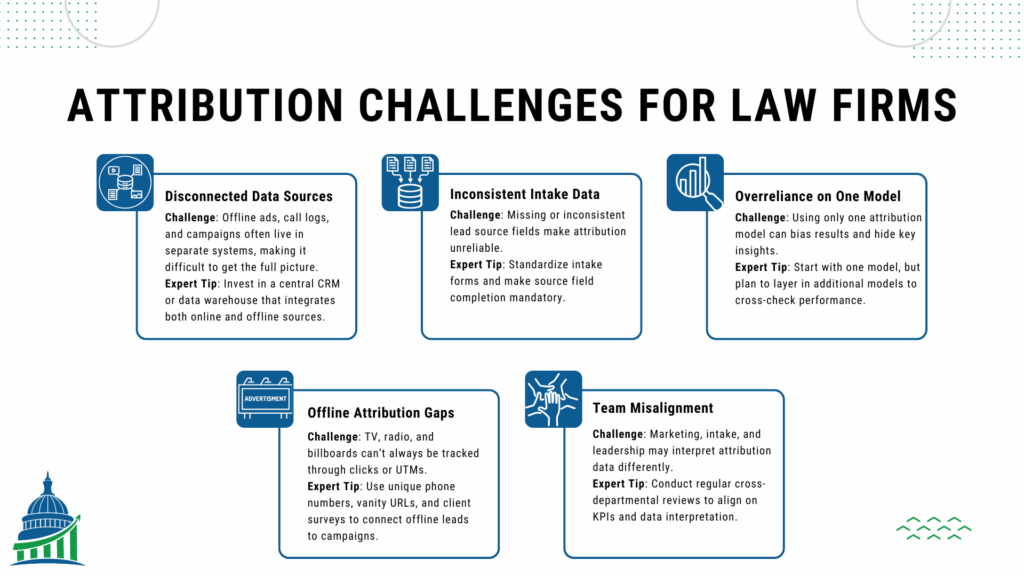Propensity models are a group of statistical models that provide immense value to your organization.
Read MoreAs the Chief Strategy Officer at a law firm, you’re constantly navigating the tension between aggressive growth targets and finite budgets. Each quarter, you’re tasked with justifying every marketing dollar, defending channel investments, and proving client acquisition results—yet 68% of law firms admit they struggle to measure ROI from digital marketing (American Bar Association, 2024). Add rising competition, increasing acquisition costs, and pressure from partners to back every decision with hard data, and the margin for guesswork disappears.
Attribution is no longer optional—it’s the foundation for turning marketing from a cost center into a predictable growth engine. Businesses using structured attribution models report a 20–30% lift in marketing ROI (HubSpot, 2024), and high-growth companies are 76% more likely to leverage multi-touch attribution (Forrester, 2024).
This article will show you:
If you’re ready to cut wasted spend, increase ROI, and make confident, data-backed decisions that scale your firm’s growth, read on.
The lesson law firms have learned time and time again is without proper attribution they are gambling with their marketing budgets. Sure, it can work for months or years, but eventually competition comes in and takes advantage of this lack of knowledge. A prime example of this is Max who works for a major law firm.
Max’s law firm was investing millions across TV, radio, billboards, and digital ads. The strategy was simple: put $5k into a channel and see if the numbers went up. For a while, it worked. Cases rolled in, partners were happy, and no one questioned the method.
Then the market shifted. Competitors got aggressive. Client acquisition costs (CAC) skyrocketed. The $5k guess and check approach could not tell them where the bleeding was worst. Marketing meetings turned into finger-pointing sessions, and every channel claimed credit for wins.
Desperate for answers, the firm implemented a scientific approach: Multi-Touch Attribution (MTA) combined with customer surveys and Marketing Mix Modeling (MMM). The results were immediate—clear visibility into which channels truly drove high-value cases. They cut spend on underperformers, doubled down on winners, and within six months increased their qualified leads.
The lesson is clear: without accurate attribution, law firms gamble with their marketing budgets. With it, they invest wisely, defend every dollar spent, and scale with confidence.

Every attribution model has its strengths and weaknesses—there’s no silver bullet. The most sophisticated law firms don’t rely on just one; they triangulate insights using multiple models to get a fuller picture. But here’s the key: walk before you run. Start with one model that fits your current sales cycle and data maturity. Get your team comfortable interpreting and acting on its outputs. Then, as your processes and integrations mature, layer in a second or third model to cross-validate results and uncover insights you’d miss with a single lens.

Even with the right models in place, law firms often encounter obstacles that can undermine attribution accuracy and ROI improvements. These challenges range from data fragmentation to offline blind spots, and ignoring them can stall your progress. Understanding these pitfalls and how to address them will ensure your attribution framework delivers actionable, reliable insights.

Once your attribution system is in place and running, the real value comes from using it to drive continuous improvement. Measurement isn’t a one-time exercise—it’s a feedback loop that informs budget shifts, campaign optimization, and strategic planning. To make this work, you must not only track KPIs but also know how to interpret and act on them.
Your attribution model isn’t a “set it and forget it” tool. It needs to evolve alongside your firm’s marketing strategy, budget, and client acquisition patterns. Here are the most common triggers for revisiting and refining your approach:
By reassessing at these inflection points, you ensure your model remains accurate, relevant, and aligned with your firm’s growth goals, allowing you to scale with precision and confidence.
The business case for lead attribution in law firms is clear: without it, you’re making expensive decisions in the dark; with it, you can invest strategically, reduce acquisition costs, and drive sustainable growth. The major takeaway is simple—accurate attribution transforms marketing from a gamble into a repeatable, scalable revenue engine.
If you have questions about which attribution model to start with, how to implement it effectively, or how to integrate it with your existing systems, reach out to Capitol Data Analytics, by clicking the CONTACT button on the top right of the page. We specialize in building attribution frameworks that give law firms the clarity they need to win in competitive markets.
Propensity models are a group of statistical models that provide immense value to your organization.
Read MoreKPI dashboards lead to data lead organizations, but what is a KPI dashboard?
Read MoreUnlock customer insights with propensity modeling. Learn model types, segmentation uses, and real examples—watch the video to boost your analytics!
Read More